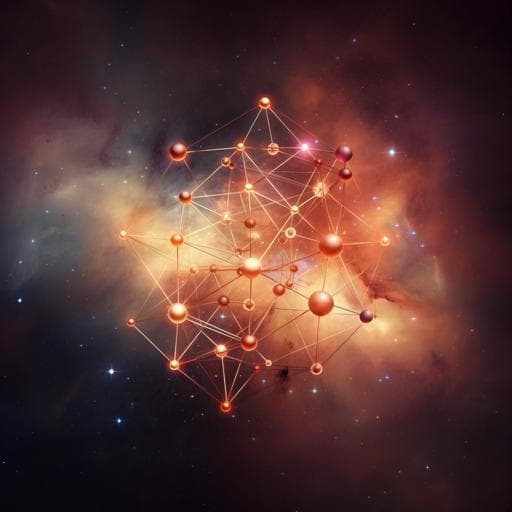
Physics
High-fidelity parallel entangling gates on a neutral-atom quantum computer
S. J. Evered, D. Bluvstein, et al.
Discover groundbreaking advancements in quantum information processing by a talented team of researchers, including Simon J. Evered and Mikhail D. Lukin. They achieved an impressive 99.5% fidelity in two-qubit entangling gates using optimal controls, paving the way for efficient error-corrected quantum algorithms.
~3 min • Beginner • English
Introduction
Errors limit the computational capabilities of current quantum devices and must be reduced sufficiently to enable efficient quantum error correction. Two‑qubit gate error rates below 1% (fidelities above 99%) are required to surpass error-correcting thresholds such as those of the surface code. Maintaining low error rates together with high parallelism and connectivity as system size scales is crucial for large-scale quantum computing. Although high-fidelity entangling operations were initially achieved on isolated qubit pairs, only recently have they been extended to larger systems (for example, 99.4% fidelity on a 72‑qubit superconducting chip and 99.4–99.6% on a 31‑ion chain). Arrays of neutral atoms offer coherent control of hundreds of qubits with flexible, reconfigurable any‑to‑any connectivity, opening opportunities for large-scale digital simulations and error-corrected computation. However, prior two‑qubit Rydberg‑mediated gate fidelities (~97.5%) have lagged other platforms. This work closes that gap by realizing CZ gates with 99.5% fidelity while operating on up to 60 qubits in parallel, using optimal-control single‑pulse gates robust to imperfections and scattering, together with experimental improvements in Rydberg excitation and atom cooling. The study also introduces multi‑qubit entangling gates (CCZ) and comprehensive benchmarking to characterize and model error sources.
Literature Review
The paper situates its contribution within prior progress on high-fidelity entangling operations across platforms. Early demonstrations achieved high fidelities on isolated pairs in trapped ions and superconducting qubits. More recent system-scale benchmarks include 99.4% fidelity on a 72‑qubit superconducting processor and 99.4–99.6% on a 31‑ion chain, highlighting the challenges of maintaining fidelity while scaling. In neutral atoms, prior Rydberg‑blockade gates reached ~97.5% fidelity. The authors build on optimal-control concepts such as time‑optimal two‑ and three‑qubit Rydberg gates, analytic pulse shaping, and dark‑state engineering related to electromagnetically induced transparency to suppress intermediate‑state scattering. Benchmarking approaches related to randomized benchmarking and subspace benchmarking are referenced and adapted here for global, parallel characterization. The work also connects to applications in error correction (surface code thresholds and demonstrations of fault‑tolerant primitives), digital quantum simulation, and prior neutral‑atom system advances enabling large-scale arrays and coherent transport.
Methodology
- Qubit encoding and single‑qubit control: Information is stored in long‑lived m=0 hyperfine qubits of Rb. High‑fidelity (>99.97%) single‑qubit rotations are driven by Raman laser pulses.
- Rydberg‑mediated entangling operations: Atoms trapped in individual optical tweezers are rearranged into designated gate sites. Entangling CZ or CCZ gates are implemented by globally pulsing Rydberg lasers that drive a two‑photon transition |1> → |r> via an intermediate excited state |e>, while |0> is off‑resonant. The Rydberg‑blockade mechanism yields conditional phases.
- Optimal‑control single‑pulse gates: Inspired by time‑optimal designs (Jandura & Pupillo), the authors generalize to a family of single‑pulse gates with a small set of tunable global parameters. Implementations include (i) a parameterized time‑optimal CZ with sinusoidal phase modulation ϕ(t)=A cos(ω t−φ)+δ and (ii) a smooth‑amplitude CZ gate. Phase modulation slope corresponds to a time‑dependent two‑photon detuning. These gates are calibrated by tuning a few global parameters to compensate systematic offsets (e.g., finite pulse rise times) and to maximize robustness.
- Dark‑state engineering to suppress scattering: To reduce spontaneous emission from |e>, the control pulses are optimized to minimize population in the bright dressed state |B> ∝ |1> + (Ω/Δ)|e> + |r> and maximize population in the dark state |D> ∝ |1> − |r>, by selecting the relative signs of the intermediate detuning Δ and two‑photon detuning and using smooth pulse shapes (particularly for the smooth‑amplitude gate).
- Experimental upgrades: (i) Increased intermediate‑state detuning while maintaining high two‑photon Rabi frequency (Ω/2π ≈ 4.6 MHz) by exciting to a lower‑lying Rydberg level (n=53) with a tenfold higher‑power laser; (ii) A‑enhanced grey‑molasses cooling and improved optical pumping to reduce temperature (radial phonon occupation ≈ 1–2), suppressing dephasing from velocity/position fluctuations.
- Gate calibration and global control: Calibration is performed globally (not site‑by‑site) by scanning a small set of parameters of the phase (and amplitude) profiles; the same parameters apply uniformly across many gate sites.
- Benchmarking protocols:
• Bell‑state method: Prepare 10 Bell pairs in parallel using a single CZ, measure parity oscillations under a global π/2 rotation to estimate Bell‑state fidelity; then apply an odd number of CZ gates interleaved with X gates to repeatedly entangle/disentangle and fit decay of Bell‑state fidelity vs number of CZs to extract per‑gate fidelity.
• Global randomized benchmarking–like method: Insert random global single‑qubit rotations (Haar‑random) between CZ gates, with a final calculated rotation to return to |00> in the absence of errors; fit decay of return probability vs number of CZs to extract F_CZ. A variant without interleaved X gates allows calibration of single‑particle phases acquired during CZ.
• Site‑resolved analysis: Evaluate fidelity per gate site across arrays to assess homogeneity and scalability.
- Error modelling: Two eight‑level atomic systems with quantitative decoherence rates (from experiment) simulate gate infidelity contributions from Rydberg decay, coupling to other Rydberg m levels, intermediate‑state scattering, and measured ground–Rydberg dephasing T2 ≈ 3 μs (dominated by laser light‑shift fluctuations and finite temperature). Correlation analyses assess error correlations across sites.
- Multi‑qubit gates (CCZ): Optimal‑control search for a time‑optimal CCZ with single‑pulse phase profile, realized on triangular three‑atom gate sites using the same global Rydberg pulse. Characterize via repeated creation of GHZ states and measurement of GHZ fidelity decay vs number of CCZ gates.
Key Findings
- Two‑qubit CZ fidelity: Using repeated‑Bell‑state method, extract per‑gate F_CZ = 99.52(4)%. Using global randomized benchmarking–like protocol with interleaved random rotations, obtain F_CZ = 99.54(2)%. A variant without interleaved X gates yields F_CZ = 99.48(2)%. Results are consistent across methods.
- Gate implementations: Both parameterized time‑optimal CZ and smooth‑amplitude CZ achieve high fidelity; smooth‑amplitude gate benchmarks at F_CZ = 99.55(3)%, demonstrating versatility and robustness to scattering.
- Parallelism and scalability: Homogeneous fidelity across 10 gate sites; scaling to a 60‑qubit system (with larger Rydberg beams at same intensity) maintains high fidelity F_CZ = 99.48(2)% with good homogeneity across the array. Calibration is global and does not grow with site count.
- State preparation and measurement: Single‑CZ Bell‑state raw fidelity 98.0(2)% with SPAM‑corrected estimate ≈ 99.4(4)%.
- System parameters and coherence: Two‑photon Rabi frequency Ω/2π ≈ 4.6 MHz; ground–Rydberg dephasing time T2 ≈ 3 μs measured; atomic cooling to near‑ground‑state radial occupation (≈1–2).
- Error budget and correlations: Modelling attributes residual CZ infidelity mainly to Rydberg decay, coupling to adjacent Rydberg m levels, intermediate‑state scattering, and dephasing (light‑shift fluctuations, finite temperature). High‑weight correlated errors are largely absent; small nearest‑neighbour covariance growth observed, possibly from correlated detuning fluctuations (T2) or long‑range interactions from decayed Rydberg atoms.
- Multi‑qubit gates: Time‑optimal CCZ found with duration only ~44% longer than time‑optimal CZ. Experimentally, repeated‑GHZ protocol across 21 qubits in parallel indicates high‑performing three‑qubit entangling gates with per‑CCZ decay consistent with F ≈ 97.9(2)%. Numerical designs extend to native controlled‑Z gates up to six qubits with durations much shorter than standard decompositions into multiple CZs and single‑qubit gates.
Discussion
The work addresses the central challenge of achieving low‑error, scalable entangling gates in neutral‑atom platforms. By combining optimal‑control single‑pulse schemes with dark‑state engineering, increased detuning and laser power, and improved cooling, the authors suppress intermediate‑state scattering and dephasing, achieving CZ fidelities ≥99.5% in parallel across tens of qubits—surpassing surface‑code thresholds. Consistency across complementary benchmarking methods strengthens confidence in the reported fidelities. The homogeneous performance across many gate sites and global calibration indicate strong prospects for scaling without increasing calibration overhead. Microscopic modelling reconciles measured infidelities with physical mechanisms (Rydberg decay, coupling to other m levels, scattering, and dephasing), and correlation analyses suggest low levels of high‑weight correlated errors, an encouraging sign for fault‑tolerant operation. The extension to fast native CCZ gates demonstrates that optimal‑control methods can generalize to higher‑order entangling operations, enabling more efficient digital simulation circuits and potentially reducing circuit depth compared with decompositions. The results thus pave the way for large‑scale digital algorithms, error‑corrected circuits, and hybrid analogue‑digital simulations on neutral‑atom processors.
Conclusion
This study demonstrates high‑fidelity (≈99.5%) two‑qubit CZ gates executed in parallel across up to 60 neutral‑atom qubits using optimal‑control single‑pulse protocols and dark‑state engineering, with global calibration and strong spatial homogeneity. Complementary benchmarking confirms performance, and detailed modelling clarifies remaining error sources. The approach generalizes to native multi‑qubit (CCZ) gates with competitive durations, and initial experiments indicate low‑error three‑qubit entanglers. These advances establish neutral‑atom arrays as a viable platform for high‑fidelity digital circuits, laying groundwork for large‑scale quantum algorithms and error‑corrected computation. Future directions include pushing fidelities toward ~99.9% via higher Rabi frequencies and larger detunings (requiring management of adjacent Rydberg coupling and pulse shaping), further suppression of light‑shift fluctuations and thermal dephasing, enhanced beam homogeneity and power for larger arrays, rigorous randomized benchmarking of multi‑qubit gates, and integration of mid‑circuit measurement (via shuttling, ancilla species, shelving, cavity readout, or ensembles) to enable full fault‑tolerant workflows.
Limitations
- The CCZ characterization via repeated‑GHZ decay does not constitute rigorous randomized benchmarking; a formal multi‑qubit gate fidelity remains to be established.
- Residual CZ infidelity arises from Rydberg decay, coupling to nearby Rydberg m levels, intermediate‑state scattering, and finite ground–Rydberg dephasing (T2 ≈ 3 μs) dominated by laser light‑shift fluctuations and finite atomic temperature.
- Scaling to larger numbers of parallel sites is constrained primarily by the need to increase laser power while maintaining beam homogeneity; managing higher intensities and pulse rise times is non‑trivial.
- Small but non‑zero nearest‑neighbour error covariances are observed, potentially from correlated detuning fluctuations or long‑range interactions following Rydberg decay.
- Present results rely on two‑photon excitation; while dark‑state engineering mitigates scattering, intermediate‑state coupling remains a pathway for error compared with potential single‑photon Rydberg excitation in alkaline‑earth systems.
Related Publications
Explore these studies to deepen your understanding of the subject.







